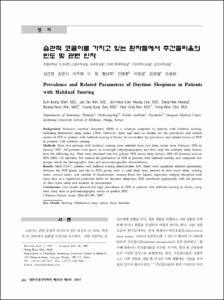습관적 코골이를 가지고 있는 환자들에서 주간졸리움의 빈도 및 관련 인자
- Alternative Author(s)
- Lee, Hyung; Cho, Yong Won; Hwang, Sang Hee; Ahn, Byung Hoon; Suh, Young Sung; Kim, Hee Cheol
- Journal Title
- 대한신경과학회지
- ISSN
- 1225-7044
- Issued Date
- 2007
- Abstract
- Background: Excessive daytime sleepiness (EDS) is a common symptom in patients with habitual snoring, including obstructive sleep apnea (OSA). However, there had been no studies for the prevalence and related factors of EDS in patients with habitual snoring in Korea. So we studied the prevalence and related factors of EDS
in patients with habitual snoring.
Methods: Sixty two patients with habitual snoring were selected from our sleep center from February 2004 to January 2007. All patients were given an overnight polysomnography and then took the multiple sleep latency tests the following day. They were classified into two groups: EDS (mean sleep latency, MSL<10 minutes) and no EDS (MSL≥10 minutes). We studied the prevalence of EDS in patients with habitual snoring and compared two groups about the demographic data and polysomnographic characteristics.
Results: Most (72.6%) patients with habitual snoring demonstrated EDS. There were significant different parameters between the EDS group and the no EDS group, such as total sleep time, percent of slow wave sleep, snoring index, arousal index, and number of desaturation. Among these, the logistic regression analysis identified total sleep time as a significant predictive factor for daytime sleepiness. MSL correlated significantly with the percent of slow wave sleep and number of desaturation.
Conclusions: Our results showed the high prevalence of EDS in patients with habitual snoring in Korea. Long total sleep time in polysomnography seems to predict EDS.
- Alternative Title
- Prevalence and Related Parameters of Daytime Sleepiness in Patients with Habitual Snoring
- Department
- Dept. of Neurology (신경과학)
Dept. of Dentistry (치과학)
Dept. of Otorhinolaryngology (이비인후과학)
Dept. of Family Medicine (가정의학)
Dept. of Psychiatry (정신건강의학)
- Publisher
- School of Medicine
- Citation
- 심은정 et al. (2007). 습관적 코골이를 가지고 있는 환자들에서 주간졸리움의 빈도 및 관련 인자. 대한신경과학회지, 25(4), 488–493.
- Type
- Article
- ISSN
- 1225-7044
- Appears in Collections:
- 1. School of Medicine (의과대학) > Dept. of Dentistry (치과학)
1. School of Medicine (의과대학) > Dept. of Family Medicine (가정의학)
1. School of Medicine (의과대학) > Dept. of Neurology (신경과학)
1. School of Medicine (의과대학) > Dept. of Otorhinolaryngology (이비인후과학)
1. School of Medicine (의과대학) > Dept. of Psychiatry (정신건강의학)
- 파일 목록
-
-
Download
 oak-bbb-2196.pdf
기타 데이터 / 422.91 kB / Adobe PDF
oak-bbb-2196.pdf
기타 데이터 / 422.91 kB / Adobe PDF
-
Items in Repository are protected by copyright, with all rights reserved, unless otherwise indicated.